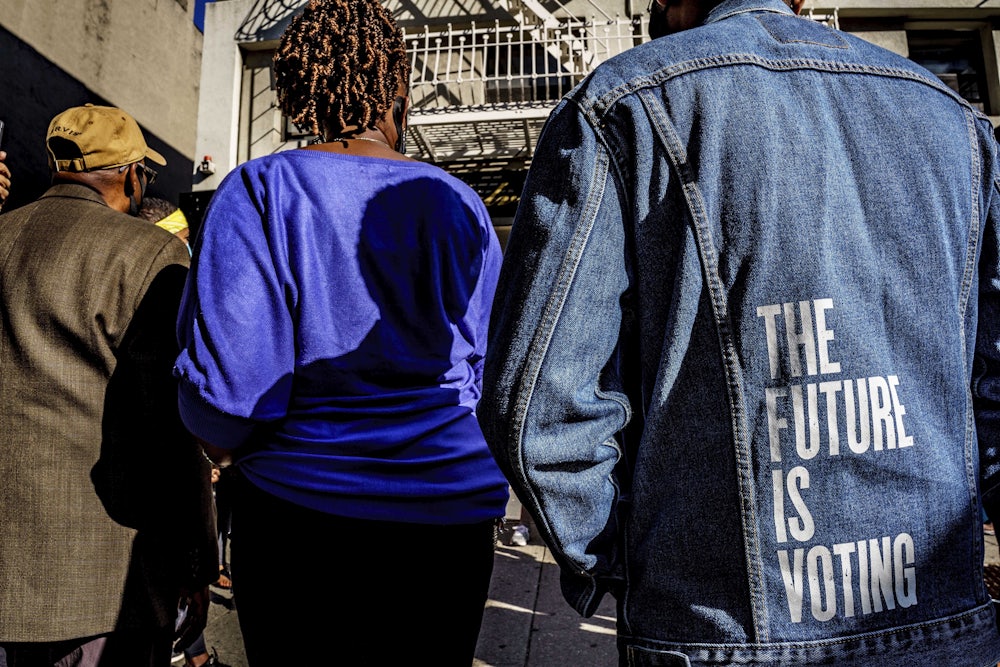At the start of 2023, a New York Times headline proclaimed “Biden Aims To Win Back White Working-class Voters Through Their Wallets.” For the past year (or decade, or arguably four decades), a great deal of media pundit time and attention has been spent waxing on about winning the working-class white vote. Competing for noncollege white voters has been and continues to be the center of political attention on both sides of the political aisle. It is likely that the lion’s share of communication dollars spent in the 2024 campaign will be directed at this important demographic group. But for the Biden campaign and national progressive organizations—should it be?
I am not saying Democrats shouldn’t compete strongly for this or any cohort of voters. Even improving their margin among white working-class voters by a few percentage points can make an important difference in a close election (and these days, they’re all close). But what I am arguing for is time and resource decisions based on reality, not romanticism. Let’s look at the data.
In 2016, according to exit polling, Democrats lost noncollege white voters by a staggering 37 points. But surely with a working-class white candidate whose roots go back to Scranton, Pennsylvania, at the top of the ticket, they made significant inroads with this important cohort in order to win, right? Wrong. On his way to winning a 51 percent majority of the vote, Joe Biden lost working-class white voters by 35 points in 2020, according to the exit polls. And in the 2022 midterms, when Democrats were able to defy history and turn back the much-predicted red wave, House Democratic candidates still lost white working-class voters by 34 points.
You don’t have to be a statistician to see the trend here. We must be clear-eyed about reality, especially in the face of Donald Trump’s success at manipulating the politics of racial grievance. It’s time to lean heavily into the changing face of the American electorate that has propelled the party’s successes and historical breakthroughs since 2008.
Democrats have been losing the white vote, and losing it badly, for decades. Jimmy Carter came close in 1976, garnering 48 percent of that vote. But ever since, Democrats have typically scored in the low 40s. That hasn’t changed. What has changed, of course, is that the electorate has become far more diverse. The real difference between Barack Obama’s majority win and John Kerry’s narrow loss in 2004, for example, wasn’t in Obama’s ability to win a significant greater percentage of white voters than Kerry. It was the well over six million more voters of color. Just looking at African American votes alone, John Kerry garnered roughly 11.8 million Black votes in 2004, while Barack Obama amassed about 16.2 million in 2008. And in 2020, Biden won roughly 17.9 million Black votes—surpassing Obama’s roughly 15.6 million in 2012. And more so than any demographic group, Hispanic voters are rapidly growing as a share of the electorate, which has been helping Democrats win. According to exit polls, in 2004 Hispanic voters made up roughly 8 percent of the electorate when Kerry narrowly lost to Bush; but in 2020, Hispanic voters made up 13 percent of the electorate, and Biden’s ability to win them by 33 points was crucial. Biden’s 2024 majority coalition will need to be built largely on the turnout and support of America’s ascending, diverse new electorate.
America’s electorate should continue to grow 3 to 4 points less white with each presidential election moving forward. According to 2008 exit polls, white voters made up roughly 74 percent of the electorate that year. If Democrats are able to generate turnout among voters of color, the electorate should be around 65 percent white in 2024.
Realistically, the Biden campaign must lean into persuading, mobilizing, and maximizing the votes of America’s growing diverse electorate if it is to again garner a majority. Trump will win a solid majority of white voters regardless of how many indictments—and convictions—he has. And when we look at the current Biden versus Trump polling that has much of the progressive community hand-wringing in anguish and fear, it’s among the ascending diverse electorate, not among white voters, where Biden is most lagging behind his 2020 performance, and where he must make up the most ground. In a January 2023 USA Today/Suffolk University poll, Biden is a whopping 24 points off his 2020 winning performance among African American voters, and a staggering 31 points off his performance among Hispanic voters. If the Biden campaign can’t close these sizable gaps in performance among voters of color, he will lose the election.
Therefore, the Biden campaign and the progressive community’s messaging should lean into the issues of democracy and freedom. Since Trump’s election in 2016, minorities in America have seen and felt the horrifying rise of hate crimes against their communities and the threats to hard-won rights, from voting rights to the right to teach the truth about our history. And the right for a woman, not the government, to make decisions about her body absolutely has antebellum echoes for Black women. So, while gas prices will always poll high as an issue, the Biden campaign must raise the stakes of the 2024 election by making it about bigger things. The campaign needs to explain in simple terms the existential threat that a Trump win would mean—a dictatorship by a man standing with white nationalists is not going to turn out well for you voters of color. And a vote for a third-party candidate who has zero chance of winning is in reality a vote for Trump.
Tactically, the campaign will need to spend the lion’s share of its resources differently than campaigns of the past. You are not reaching younger voters of color on broadcast; the campaign will need to take the fight against Trump to the digital and social media space like never before. It will need to flood the zone day and night across all social media platforms. Our polling data shows the least motivated Black voters are hearing more negative than positive information about Biden on social media. That must change.
The campaign should engage surrogates who are influencers with cultural competence in the Hispanic and Asian American communities. They should immediately tap Representative Jasmine Crockett of Texas, who has a knack for going viral and putting loud and often factually wrong Republican colleagues in check. She’s a young and dynamic African American leader who can meet younger voters of color where they are culturally and socially. And while historically the vice president has played a background role in campaigns, Kamala Harris is a unique historical political figure, and the campaign should give her a uniquely larger role than is typical. More so than any Democrats on the national stage right now, she reflects and is a symbol of the changing face of the American electorate, and team Biden should let her have a uniquely larger role engaging an electorate that might see more of themselves in her than in the president.




